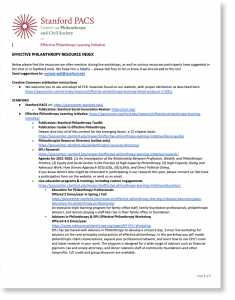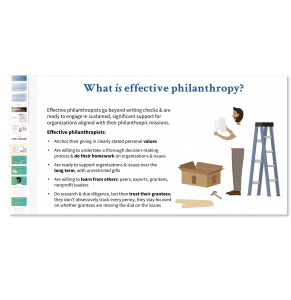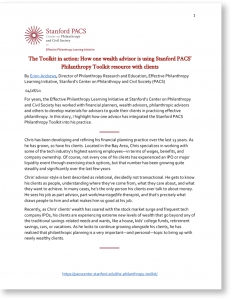Advisor’s Manual
The Philanthropy Toolkit: An Advisor's Manual
This toolkit is designed for advisors interested in integrating philanthropic planning into their practice to better meet the needs of their clients. Philanthropic planning emphasizes developing a philanthropic focus and vision, understanding how to provide meaningful support to organizations working on social and environmental issues, and, if your clients wish, establishing a personal legacy.
This Advisor’s Manual section gives you some context on the research we conducted with advisors, as well as some client-oriented conversation starters. The following six sections of the toolkit provide detailed information and resources and use interactive activities to guide you and your clients through the philanthropic process.
Your client may complete the toolkit independently or with your facilitation. Some clients may want to include their family.
We encourage you to make this toolkit work for your client’s unique needs. You can work through it in order, or you can jump to the sections that apply to the current stage of your client’s philanthropy. Spend as much time as your client
needs to address the objectives in each section. You do not need to have all the answers. Your goal as a facilitator is to encourage your client to make informed, thoughtful decisions and to continue learning along the way.
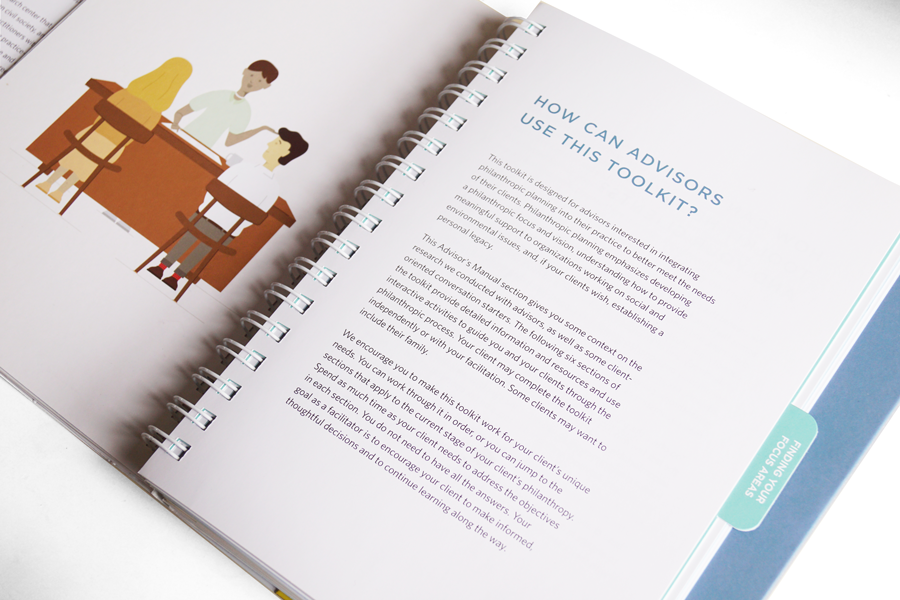
How can this Toolkit help you and your clients?
We created this toolkit in collaboration with hundreds of advisors across the United States in response to the philanthropic questions, challenges, and opportunities their clients face every day. High-capacity individuals are increasingly requesting guidance on their philanthropy, and often engage an ecosystem of advisors who are uniquely positioned to provide this support—including wealth advisors, tax and estate lawyers, etc. Clients want to navigate philanthropic planning with advisors who are already familiar with their circumstances.
Too often, the philanthropic conversation is overlooked or left to the last few minutes of a client-advisor meeting. Many advisors feel uncomfortable raising the subject of philanthropy because they don’t have a clear framework to use with their clients to walk them through the process. Advisors are trained to focus on tax optimization and ease of use in charitable planning, but this does not necessarily lead to the most values-based, effective approach for the clients. Despite these challenges, there are many benefits for advisors who are ready to engage in more meaningful, informed philanthropic discussions with their clients.
Advisors are well positioned to help clients balance the natural tension between the fear of running out of money and the desire to have an impact during their lifetime. In many cases, clients don’t realize how much they can give and end up looking back over lost opportunities.
As a trusted advisor, you can encourage your clients to reflect on their motivations and goals, prepare them to engage the nonprofit sector, and help them develop a robust, value-aligned giving strategy that fits their unique needs.
In an increasingly competitive landscape, the ability to provide philanthropic advice can help you:
- deepen your personal relationships with clients and their families
- differentiate your practice by offering philanthropic guidance that is in high demand and low supply, giving you a comparative advantage over advisors who are not providing this service
- retain current clients and their next generations
- expand your client base to include other high-capacity individuals who want to integrate philanthropy and wealth planning
- help your clients make the world a better place according to their values
- share in the pride of maximizing your clients’ philanthropic impact
Our research indicates that high-capacity donors find tailored, philanthropic conversations with their wealth advisors extremely helpful.
How can you use this toolkit?
The Philanthropy Toolkit is composed of six modules, each module addresses different aspects of philanthropic planning process. We encourage you to make this toolkit work for your client’s unique needs. You do not have to go through the modules in order—feel free to use the toolkit modularly.Your client can work through each module with you during your meetings, or on their own and use your meetings to discuss completed modules. Additionally, you can cover multiple modules in one meeting, or focus on one module over several meetings. You can also involve family members in the process if your client so desire.
Once you have clarified your client’s interest in philanthropy, you can ask whether they are interested in having focused, structured conversations about giving in your meetings. When you present this toolkit to your clients, highlight how it can provide structure and tailored guidance for each step of the decision-making process, and that the toolkit also includes references for additional resources and networks that support an individual’s philanthropic learning and giving journey.
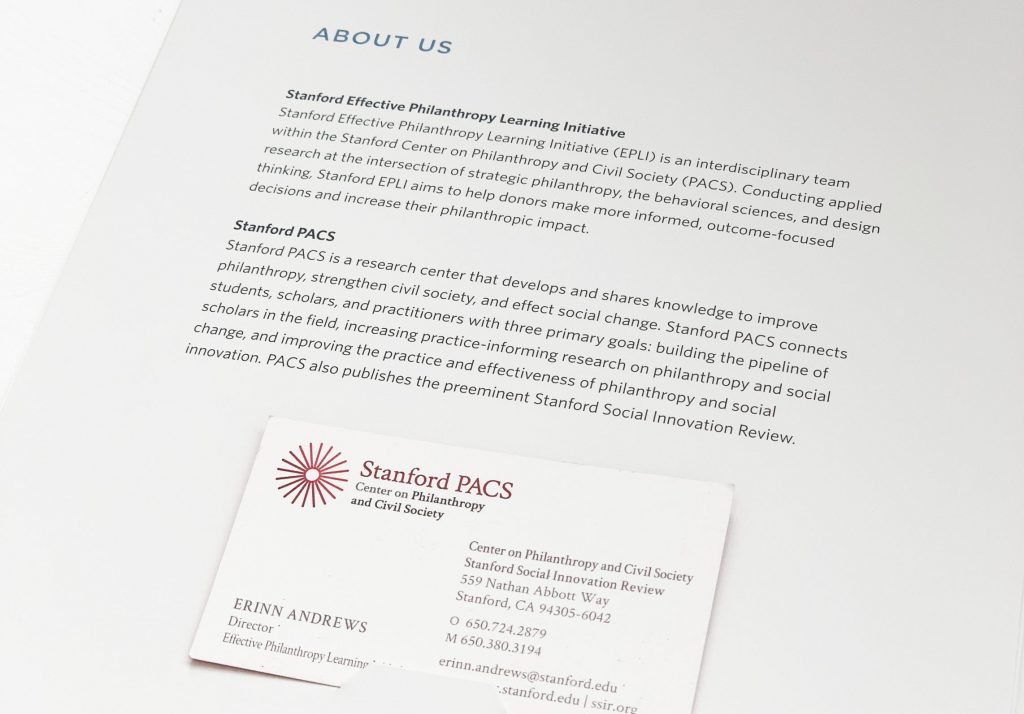
How to use these resources with your clients?
Using the Toolkit
Before walking a client through the toolkit, we encourage you to go through each module yourself, applying the questions to your own philanthropic practice. In doing so, you will understand the content and the user experience more deeply. The Toolkit Primer (found here) will also help you navigate the toolkit in response to specific philanthropy-related questions.
Once you feel comfortable with the toolkit, identify a few clients who might be interested in incorporating philanthropic planning and this toolkit into their financial planning process. You may want to consider clients who have previously raised questions about their giving, or clients who have recently experienced a pivotal moment and for whom philanthropy may now be a higher priority—such as new empty nesters, recent retirees, or people managing greater wealth as the result of selling their business or receiving an inheritance.
Supplementary Materials for Advisors
We’ve created some supplementary materials for you to email your clients or use in client presentations. Below is a powerpoint presentation you can use to teach clients about effective philanthropy, a resource index we often use in our live workshops, and a case study about how one advisor uses our materials.
CONVERSATION STARTERS
When proactively starting the conversation, you may want to gauge your client’s interest in philanthropy with a few opening questions. These questions allow you to get to the deeper values and motivations behind your clients’ philanthropy.
If using these starting questions seems intimidating, consider role-playing the conversation with a colleague to prepare for a client meeting. Experiment with these questions until you have identified which questions, or how to revise these questions, so they feel natural to you.
Is philanthropy (charitable giving) important to you right now, or is it something you’d like to revisit in the future?
Tell me about your family’s values.
- What are some values that you and your family share?
- What values do you want to pass along to your family?
- How might these values inform your wealth planning process or your charitable giving?
- Is this something you would like to explore further in our meetings?
What issues are you (and your family) passionate about? Why? (Tell me more.)
- Are you aware of any organizations that are working on these issues?
- Are you involved with any of these organizations?
- Have you given to any organization that you are excited about? If so, why?
- Is this something you would like to explore further in our meetings?
Tell me about some important life experiences that have affected you.
- How might these experiences inform your wealth planning and/or your charitable giving?
- Is this something you would like to explore further in our meetings?
What aspects of your identity are important to you?
- How does this affect how you view your wealth planning or your charitable giving?
- Is this something you would like to explore further in our meetings?
Have you thought about what kind of legacy you want to leave?
- Is this something you would like to work on now, or something you’d like to revisit in the future?
TOOLKIT PRIMER
Show your client the Primer to help them navigate the toolkit in response to specific, philanthropy-related questions:
 This work is licensed under a Creative Commons Attribution 4.0 International License.
This work is licensed under a Creative Commons Attribution 4.0 International License.

